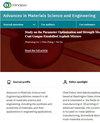Influence of Tool Pin Profiles on Aluminium Alloy A356 and Ceramic-Based Nanocomposites for Light Weight Structures by Friction Stir Processing
4区 材料科学
Q2 Engineering
引用次数: 0
Abstract
In this research, the main aim is to focus the enhancement of aluminium-based metal matrix composites for improving the attributes of light weight metals, aerospace structures and other tailor blank material properties. By this way, the friction stir processing (FSP) was the suited alternate technique to enhancing the mechanical attributes and superior microstructural amendment in the processed MMCs. Therefore, this study investigates the dispersion of ceramic-based strengthening particles of chromium oxide (Cr2O3) in the aluminium base matrix of A356 alloy. During the processing, the different tool pin sizes having the conical threaded tool pin profiles. Similarly, the tool spinning speed and tool travel speed also varied while in FSP. Before the processing, the A356 alloy was prepared by the grooved surfaces for packing the chromium oxide particles to compose the aluminium metal matrix composites. The tensile strength and hardness was employed to carry out from the friction stir processed A356 alloy with influencing of Cr2O3. The maximum occurred tensile processing parameters are 1500 rpm of spinning speed, 6 mm of tool pin sizes and 90 mm/min of tool travel speed. Similarly, the maximum obtained hardness processing parameter are 2000 rpm of spinning speed, 5 mm of tool pin sizes and 90 mm/min of tool travel speed. A scanning electron microscope was utilized to investigate the dispersed Cr2O3 in the A356 alloy for confirming the refinement grains in the nugget zones of FSPed A356 alloy. The increased grain boundary by the influence of different tool pin sizes was the major reason to produces the better mechanical properties in the processed A356/Cr2O3.工具销轮廓对通过摩擦搅拌加工制造轻质结构的铝合金 A356 和陶瓷基纳米复合材料的影响
这项研究的主要目的是提高铝基金属基复合材料的性能,以改善轻质金属、航空航天结构和其他定制毛坯材料的属性。因此,摩擦搅拌加工(FSP)是提高加工后金属基复合材料机械属性和微观结构修正性能的合适替代技术。因此,本研究调查了陶瓷基强化颗粒氧化铬(Cr2O3)在 A356 合金铝基体中的分散情况。在加工过程中,不同尺寸的工具销具有锥形螺纹工具销轮廓。同样,刀具旋转速度和刀具移动速度也在快削加工过程中发生变化。加工前,A356 合金的表面开槽,以便填入氧化铬颗粒,从而形成铝金属基复合材料。拉伸强度和硬度是通过影响 Cr2O3 的摩擦搅拌加工 A356 合金来实现的。最大拉伸加工参数为旋转速度 1500 rpm、工具销钉尺寸 6 mm 和工具移动速度 90 mm/min。同样,获得的最大硬度加工参数为旋转速度 2000 rpm、刀具针脚尺寸 5 mm 和刀具移动速度 90 mm/min。利用扫描电子显微镜研究了 A356 合金中分散的 Cr2O3,以确认 FSPed A356 合金金块区的细化晶粒。受不同刀针尺寸的影响,晶界增大,这是加工后的 A356/Cr2O3 具有更好机械性能的主要原因。
本文章由计算机程序翻译,如有差异,请以英文原文为准。
求助全文
约1分钟内获得全文
求助全文
来源期刊

Advances in Materials Science and Engineering
Materials Science-General Materials Science
CiteScore
3.30
自引率
0.00%
发文量
0
审稿时长
4-8 weeks
期刊介绍:
Advances in Materials Science and Engineering is a broad scope journal that publishes articles in all areas of materials science and engineering including, but not limited to:
-Chemistry and fundamental properties of matter
-Material synthesis, fabrication, manufacture, and processing
-Magnetic, electrical, thermal, and optical properties of materials
-Strength, durability, and mechanical behaviour of materials
-Consideration of materials in structural design, modelling, and engineering
-Green and renewable materials, and consideration of materials’ life cycles
-Materials in specialist applications (such as medicine, energy, aerospace, and nanotechnology)
 求助内容:
求助内容: 应助结果提醒方式:
应助结果提醒方式:


